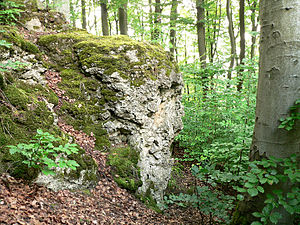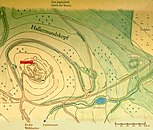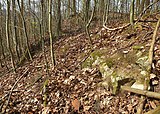Hallermund Castle
| Hallermund Castle | ||
|---|---|---|
|
Building remains on the steep slope |
||
| Creation time : | before 1189 | |
| Castle type : | Summit castle | |
| Conservation status: | Remnants of walls, walls, ditches | |
| Standing position : | Count | |
| Place: | at jump | |
| Geographical location | 52 ° 11 '2.6 " N , 9 ° 34' 18.5" E | |
| Height: | 218 m above sea level NN | |
|
|
||
The castle Hallermund with its sparse remains of a Postal approximately 2.5 km south of Springe in the Hanover region in Lower Saxony . The hilltop castle, first mentioned in 1189 , was the center of power for the County of Hallermund . The complex, which had become a robber baron's castle , was razed during a feud in 1435 and was no longer rebuilt. Your few remains are within the walled Saupark Springe and are accessible during the opening times of the park.
location
The castle was located on the steep, conical hilltop of the Hallermundskopf 218 m above sea level . He is on the east side of the Little Deister . The castle grounds are located within the Springe Saupark about 500 m as the crow flies south of the Springe hunting lodge , where the main entrance is located. Today one of the Saupark's hiking trails leads up to the castle site, for the last few meters as a narrow and steep path. Due to the winding paths, the distance from the hunting lodge is about 1.2 km.
history
The castle was the center of the small county of Hallermund . It was only inhabited for a short time by the counts, as they resided in Springe. The first written mention of the complex was in 1189 when Ludolf and Wilbrand von Hallermund pledged the castle to Bishop Adelog von Hildesheim . Due to disputes with the Guelphs , the Counts of Hallermund increasingly lost their influence and importance in the 13th and 14th centuries. In 1282 they pledged the castle to the Guelphs, to whom all their privileges were transferred in 1411. The people of Hallermund lost the castle, but they owned large estates in the area until their family died out in 1436. In 1386, the Guelphs appointed the Counts of Spiegelberg as pledge owners of the castle. Count Moritz von Spiegelberg was not always loyal to his pledges and converted the fortification into a robber baron castle. The Guelphs put an end to this hustle and bustle through Duke Heinrich the Elder of Braunschweig in the Spiegelberger Stiftsfehde 1434/35 on behalf of the surrounding cities of Hanover , Hildesheim , Pattensen , Münder . They razed the castle, which was not rebuilt afterwards.
Building description
The castle stood on the oval plateau of the hilltop, which measures 50 × 30 m. The appearance and structure of the castle have not been passed down figuratively, which is due to its early and complete destruction in 1435. From 1243 a castle chapel is documented at the castle. In addition to its defenses, probably a ring wall and keep , the castle is said to have had a forge and residential complexes.
Structural remains are only present as loose stones, pieces of roof tiles and remnants of walls. On the edge of the plateau there are larger holes in the ground that indicate collapsed cellars of earlier buildings. If the foundation remains on a steep edge, it is likely to have been a tower or another building. Immediately below the hilltop, the castle complex is surrounded by a moat with a rampart. Today the castle plateau is overgrown by young deciduous trees and can therefore only be walked on on a path. About 300 m east of the castle complex there was a smaller outpost, which today consists only of wall remains.
About 200 m below the castle is the donkey pond, which was dammed from the donkey stream. The stream and pond probably served the castle's water supply and fish farming. At the pond archaeological excavations in 1820 made finds that can be attributed to the castle users. These were horseshoes, remains of walls, bones, ceramics, pieces of iron as well as silver and gold jewelry. After a renovation in 2007, the pond is filled again today (2012).
In 2014, employees of the Lower Saxony State Office for the Preservation of Monuments carried out a large-scale prospecting in the castle area using metal probes , as grave holes were found on the castle grounds . This led to the discovery of crossbow bolts , projectiles made of lead, horseshoe parts and ceramic remains. Non-ferrous metal finds include items of daily use and items of clothing such as appliqués and buckles. Coins found a Brakteat of the Roman Catholic Diocese of Hildesheim from around 1250 and a silver Hohlpfennig from Hamburg from the 14th century and a medieval silver penny. An outstanding find was a triangular brooch ( Fürspann ) with four inlays made of river mussels.
literature
- Hans-Wilhelm Heine : The Hallermundskopf in the Saupark near Springe . In: Guide to Prehistoric and Protohistoric Monuments . Volume 49: Hanover - Nienburg - Hildesheim - Alfeld . Part II: Excursions . Zabern, Mainz 1981, pp. 188-191, ISBN 3-8053-0548-6 .
- Harald Nagel, Friedrich-Wilhelm Wulf : 116 Springe FStNr. 53, Gde. City of Springe, Region Hanover. In: Fundchronik Niedersachsen 2014. (= News from Lower Saxony's prehistory . Supplement 19). 2016, ISBN 978-3-8062-3308-7 , pp. 86-87.
Web links
- Entry by Stefan Eismann on Hallermund Castle in the scientific database " EBIDAT " of the European Castle Institute
- Hallermund Castle in the Lower Saxony Monument Atlas
- Description by the Friends of the Landesmuseum Hannover







